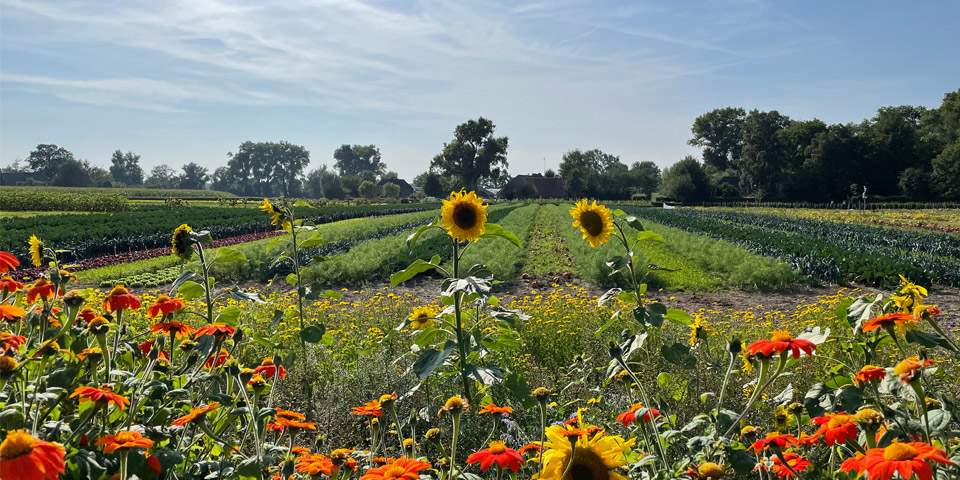


Due to the alarming loss of biodiversity and the negative impact of climate change, there is an urgent need to develop new resilient production systems.
It is important to have alternatives to monocultures. This research aims to study how crops perform together in intercropping systems. The next goal of scientists and plant breeders is to breed new varieties that will perform better in strips.
Marcel van Diemen is a plant breeder at Vitalis, the organic seed company in Voorst, Gelderland. Through research, selection, and crossbreeding, Vitalis aims to develop better organic vegetable varieties. Vitalis works closely with Dr. Dirk van Apeldoorn (Farming Systems Ecology) and Dr. Guusje Bonnema (Plant Breeding) of Wageningen University to study an intercropping system of a 1-hectare plot. To accomplish this, observing how plants interact with their surroundings beneath and above the ground is essential.
The field consists of 33 strips. Each strip of the research field is 1.5 m wide and 140 m long. A different crop is grown on each strip. The crops grown in this intercropping system are leek, fennel, lettuce, pumpkin, cauliflower, and grass/clover. For every crop, they use three varieties in 3 repetitions per strip. This research will be repeated in the next five years using a 1:6 crop rotation.
Guusje Bonnema, assistant professor in Wageningen, says strips of crops have a bright future: "This principle works for organic and conventional agriculture," she says. "Several growers in the Netherlands are already working with it. But more scientific knowledge is needed."
Studies have shown many positive effects of growing crops in strips. "We catch insects here and do that on a different field further down where we only have pumpkins in monoculture. At the strips with various crops, insects are important, says Bonnema. "The natural pest control agents in the crop can be in the adjacent strip. And this is the best way to fight insect infestations and diseases."
Van Apeldoorn: "If you have a disease in the leek, the damage is limited to one strip. The other crops next to it act as a buffer, and the disease does not spread to another strip of a leek a little further away. Additionally, strip cultivation increases yields and more effectively uses soil nutrients than monocultures. Finally, biodiversity improves. On land with strip cultivation, there are more insects and birds. The ecological functions in the soil are better. As a result of having different crops, you also have separate living environments where insects like to live.

These positive effects have been demonstrated based on scientific research and practical experience. The study by Bonnema and van Apeldoorn should clarify why leek might grow well with cabbage but not with fennel and that it may also vary by crop type. Bonnema says: "What crops, and varieties combine well together, and is there a genetic basis for how plants respond to their neighbours? Our goal is to collect as much data as possible about plant characteristics. Selecting the right plants and crossing them is the first step in breeding. Then you choose again and start crossing again. A brand-new variety takes six years to develop, cross, and select. That is why we must act quickly."
Van Diemen: "When I have my hands in the ground, I can smell and taste the vegetables. But the new generation, the scientists in Wageningen, collect data, usable data with which we can work. In addition, they provide us with a graph showing the plant's strength. That is, of course, an excellent addition to what we can see ourselves. We look at the yield, the quality, and the taste. But with extra data from Wageningen, we can make better plant selections."
Growing in smaller strips may be less practical for growers because of potential inefficiency, but Bonnema believes this should not be a consideration. Strip cultivation not only shows promising yield, reduces diseases and, therefore, the use of pesticides but also increases biodiversity and improves the quality of the crops, which are all measurable signs of progress. Farmers using intercropping systems are inventive and future oriented. A new generation of machines is already developing these types of agriculture.
Bonnema: "Irrespective of what growers choose, there will also be stricter rules from the government. You must have an alternative to the monoculture that current agriculture works with."
Source: Trouw magazine 2021.
Waarom prei beter groeit tussen de bloemkool en de venkel | Trouw